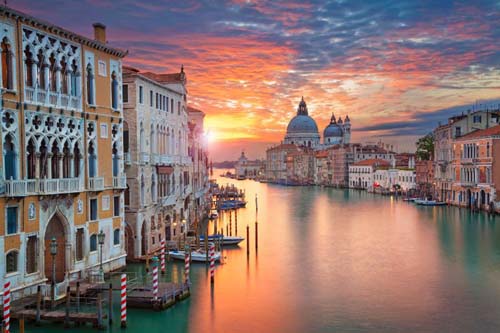Italy: A love letter to Venice and its people

Venice: If you’re looking to try a Venetian’s patience, ask for the secrets of the city. Where are the hidden churches, the right hot spots, the cicchetti bars? Which is the best, the rarest, the most obscure? There is little they haven’t been probed about a thousand times before.
“Everybody asks,” says Bianca Arrivabene, who, although she inhabits a portion of one of La Serenissima’s grandest palazzos, is not technically a Venetian—as she is quick to point out. “My children are,” says Arrivabene, a tall and improbably down-to-earth woman born a princess and married to Count Giberto (to whom she was already distantly related through a common ancestor, Louis XIV of France).
Venetians, she says, “do the same as you do,” as though it were everybody’s privilege to go about the tasks of everyday life against the most gorgeous backdrop in the world. “We walk. We go for coffee. We take the ferry to the Lido on Saturday for a stroll on the beach.”
Elena Micheluzzi, glass artist, dodges traffic at the Squero di san Trovaso. Glass and gondolas, enduring symbols of Venetian craftsmanship, cross paths during Homo Faber, the citywide artisanal celebration. The Squero di San Trovaso is the oldest of Venice’s three remaining boatyards. Micheluzzi, a Muranese virtuoso and daughter of glass eminence Massimo Micheluzzi, is the next generation vessel for an ancient practice.
Habits of reserve and caution are common to inhabitants of islands and small towns, and Venice is both. A series of islets built on unstable mud flats at the edge of a mercurial sea, the city sits atop the pinnacle of global tourism, but in many ways it functions like Mayberry on the Adriatic.
This sense was brought home during the past two years, over several waves of Covid-19, when a city previously in peril of being overwhelmed by daytrippers grew suddenly, eerily still. Everyone read the tales of Venice miraculously restored to a calm appropriate to its nickname: La Serenissima means “most serene.” The waters of the lagoon, some claimed, were suddenly so undisturbed you could see straight to the bottom. A trip to the grocery store, for once, did not require a battle plan.
A long view of its history suggests that Venice has seldom been the placid place of legend. True, its geography made it seem a place apart, a liminal city straddling East and West. It is also the case that as an oligarchic republic it was rigidly kept under the control of a few. And yet throughout the centuries of its global might, outlanders thronged the place. This was well before tourists became its primary money crop.
Toto Bergamo Rossi, preservationist, watches over his garden at Palazzo Gradenigo. “We have treasures everywhere and nobody knows,” says the Venetian Heritage director, who has made it his mission to restore, conserve, and spread the word about the city’s hidden gems. His latest project, with longtime benefactor Louis Vuitton, is the multiyear renovation of the Ca’ D’Oro, the Gothic palazzo.
Consider, for some useful perspective, the gondola, that enduring symbol of the city, and the fact that while just 433 licensed gondoliers today paddle their glossy-hulled craft through the city’s 177 canals, that number was once 10,000 or possibly more. “It was a free-for-all,” says Robert Davis, professor emeritus at Ohio State University and a scholar of Italian history, of the boat traffic in the 18th century and before.
You can see it in the canvases of Canaletto, many of whose journalistic views of the city depict waterways as gridlocked as the Long Island Expressway on a summer Friday. To live in Venice, then and now, strategy has always been required. One path to success is to follow the lead of locals—some native, some part of a wave of recent arrivals from the worlds of art, fashion, and film—who have insinuated themselves into the life of a city that, while it can seem like a mirage, is underneath a gritty little town.
“Even after having lived here for 30 years, I still get surprised,” says Chiarastella Cattana, a designer of linens whose shop in the Santo Stefano district is an obligatory destination for the cognoscenti. “The gift this town can give to people is that there is always another layer, another secret waiting to be revealed behind a door.”
Skye McAlpine, cookbook author, treats younger son Achille to goodies from her garden at Palazzo Gradenigo. A Brit who grew up in Venice from age six, the two-time best-seller is serving her hundreds of thousands of followers a third helping soon. More chocolate tart, anyone?
Yet isn’t it true that Venice by nature is reluctant to disclose its private side? Yes and no. “When you see an open door, go in,” Arrivabene says one afternoon, just as the Biennale’s preview week is getting underway. (The show is on view through November.) When I remark that with her name and title come advantages not available to the likes of me, she bats the notion away. “Not at all,” she says, reminding me of a January visit, when we met for dinner at Bruno Gavagnin and Luca di Vita’s 22-seat Osteria alle Testiere. “I’d only eaten there once before. I could never get in.”
It was on the same trip that Arrivabene arranged an early morning visit to the Cini Foundation, a little-known gem on the island of San Giorgio Maggiore where both the Michelangelo Foundation’s sprawling artisanal showcase, Homo Faber, and the artist Kehinde Wiley would soon set up exhibits (the latter on view through July).
There, in a cold mist, we wandered about the austere cloisters of a monastery founded in the 10th century, renovated in the 16th with a portico and refectory by Andrea Palladio (who, Arrivabene noted, built very few palaces in Venice because local architects, jealous of his genius, assiduously edged him out), and ornamented by Veronese at about the same time.
Mario Codognato, curator, on the move outside Palazzo Manfrin. Juggling papers is all in a day’s work for the director of the Anish Kapoor Foundation and the artistic director of Berggruen Arts & Culture, which is reopening Palazzo Diedo in 2024. Two Kapoor shows are on view through October, including one at the artist’s own Palazzo Manfrin.
Until the fall of the Venetian Republic, the painter’s masterpiece, The Wedding Feast at Cana, hung in the refectory at the monastery. Then Napoleon ordered the massive canvas sliced into strips and shipped to the Louvre, where it still hangs. These days a scientifically rendered and miraculous reproduction hangs in its place.
There is nothing mysterious about the Cini Foundation; it is hidden in plain sight opposite the Piazza San Marco on the Grand Canal. That I had never visited it before underscores the importance of acquainting yourself with the city’s vaporettos by way of a system map, now smartphone-accessible. This has become even more useful now that the hordes are once again descending in numbers so great that on a recent weekend it was all but impossible to cross the Rialto. Says Cattana, “You might as well jump in the canal.”

Antonia Miletto, jeweler, walks her dog Teo on Salizzada san Samuele. The maestra of San Marco is known by neighbors for her long-haired dachshund and by New York’s cognoscenti through her exclusive perch at Fred Leighton.
In Venice, those who live there say, it is important always to have a workaround in mind, a plan B. Often that means venturing to the outer islands, as savvy newcomers and locals do. Take the young aristocrat and glass designer Marcantonio Brandolini d’Adda, who considers the untrammeled district of San Pietro in Volta “my very favorite place and destination in the lagoon.” Forget all the Harry’s Bar hype and pricey Bellinis (which are almost as good, anyway, in $17 takeout bottles). For roughly the price of two drinks at the bar there, you can enjoy a whole delicious meal at a waterside joint like Da Celeste, which also offers peerless views.
For Cattana, who lives in the quiet Dorsoduro sestiere, a necessary retreat from the tourist madness comes in the form of Sunday hikes along the Lido. Hopping the vaporetto, she rides 20 minutes to the barrier island and then strolls north, where a 1930s aerodrome contains a restaurant whose windows overlook a grass landing strip reserved for private charter flights and, it can seem, time machines. Nina Yashar, the canny doyenne of Milanese design, curated two exhibits at the Giovanni Nicelli Airport (on view until the end of June).
Marcantonio Brandolini d’Adda, entrepreneur, after kitesurfing on the Lido Marie. Brandolini’s heir turned her glass label, LagunaB, into an incubator for artistic and environmental innovation. The company’s project, Vital, with nonprofit We Are Here Venice, helps restore the lagoon’s salt marshes.
For Federico Marchetti, the Italian e-tailing magnate behind Yoox Net-a-Porter Group (whose personal residential portfolio is vast), the idyllic Lido is a sleeping beauty waiting to be revived. “Some people would say don’t tell anybody, and that’s the typical Italian attitude of keep it for ourselves,” he says.
Marchetti was accompanying his friend the filmmaker Luca Guadagnino two years back, during the Venice International Film Festival, when he happened upon an Art Nouveau villa held by the same family since its construction in the 19th century. Impulsively (and shrewdly) he bought the place and is now, with the aid of Guadagnino, restoring the house and gardens to their former glory. Whim also overcame prudence for the Colombian footwear designer Edgardo Osorio of Aquazzura, who, when looking for a quarantine rental, came across a palace opposite the Arrivabenes’ stupendous Palazzo Papadopoli and settled in, earning the nickname Palazzo Margarita for the property in honor of his favorite (albeit decidedly non-Venetian) cocktail.
While there have always been those who would preserve Venice in amber, its savvier residents understand that framing the city as a Renaissance Disneyland spells creeping death. Still, before the pandemic, budget tourism had reached a breaking point. “The worst year of my life was 2019,” says Toto Bergamo Rossi, who as director of the Venetian Heritage nonprofit brought in Louis Vuitton to support the latest restoration of the Ca’ d’Oro, a 15th-century Gothic palazzo. The survival of the exquisite urban masterpiece that is this city lies in taking the middle path, he says: “Venice has to be run like a museum—with us inside.”
mafalda bianca vera with bricola count giberto and viola arrivabene
From left: Mafalda, Bianca, Vera (with Bricola), Count Giberto, and Viola Arrivabene Make a Drop-off alla Veneziana on Canale di san Polo. There’s precious cargo in these boxes: furlane slippers by the young label from Vera and Viola, the next generation of a dynasty that has lived at Palazzo Papadopoli (just out of this shot) for two centuries.
And if once again Venice seems threatened by a Vesuvian flow of tourists (an estimated 22 million annually in a city of only 55,000), insiders know there is always a way to find your personal flow. Designer Rick Owens, a Californian and decadeslong resident of Paris, began spending part of every summer at the grand Excelsior Hotel on the Lido 15 years ago, lured there by “the faded grandeur.” Nowadays his visits extend to several months a year, and his routine is banal by design. “I live my ordinary life, and then I can take the vaporetto to the Piazza San Marco and enjoy the pageantry.”
That may be the key to understanding the city. Venice is no more itself for Venetians than for first-time arrivals. “Whoever you are, it’s a place where you can always make a discovery, if you are curious,” Arrivabene says. Why anyone should be daunted by the place, she professes not to know. “I mean, it’s an island. You can’t go anywhere wrong. You can’t fall off.”





